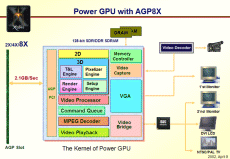Vendor:
PowerColor
Product:
Evil Xabre 400 AGP8X
Chipset:
SiS Xabre
400

One of the problems both ATI and NVIDIA face is that with the integrated video market becoming more popular, and Intel being every successful at it, their graphics market share has shrunk because integrated video is always going to be cheaper than even the lowest end discrete board. However, the low end is where the volume is and both NVIDIA and ATI need to do something to protect these markets, so they are increasingly becoming more serious about the chipset markets and integrated video themselves.
The likes of SiS are caught in the middle - already competing with Intel and VIA in the chipset arena, they now see NVIDIA and ATI increasingly encroach on their turf. Their answer... compete in their ground as well!
The Xabre series of graphics boards are SiS's entry into the low end graphics market.
Xabre Features
Before we take a look at the PowerColor board, lets have a quick rundown of the features in the Xabre chip.
We can see from the chip diagram that the Xabre chip is designed to operate using a 128-Bit memory bus, capable of utilising SDR or DDR memory types. SiS have termed the memory controller as the "Frictionless Memory Controller" to "boost effective memory bandwidth and improve overall memory efficiency". Although this is marketing speak, it does imply that there may be some memory bandwidth optimisations within the chip.
| Specifications | |
| Chipset | SiS Xabre |
| Silicon Process | .15µ |
| Engine Clock | 250MHz |
| Memory Interface | 128-bit interface DDR/SDR |
| RAMDAC | 375 MHz |
| Bus Standard | AGP 8X/4X |
The Xabre 400 supports multiple outputs, with a VGA, DVI and TV-Out connectors. The secondary output is facilitated by an extra SiS301 chip, which handles the TV-output, DVI or secondary VGA.
With regards to 3D support, this is a DirectX8.1 chip with support for Pixel Shaders up to version 1.3. Although SiS have included Pixel Shader capabilities in the chip, they have not decided to use hardware Vertex Shaders, instead relying on the software Vertex Shader path. Interestingly, although they didn't include Vertex Shaders, they do have a hardware Transformation and Lighting Engine - a slightly odd mix you may think, but one that probably suits the current mix of gaming titles quite well.
The Xabre 400 was also one of the first graphics products on the market to support the newly emerging AGP8X standard.

